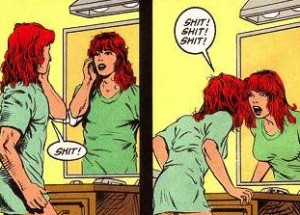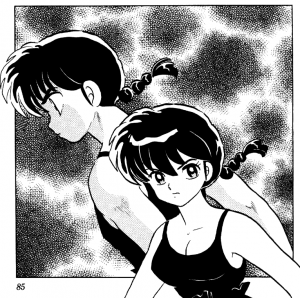
Earlier this year, Andrew Wheeler of ComicsAlliance listed resolutions that he wanted the comics industry to achieve. Among these resolutions was trans representation in the Big Two for superheroes. This has not yet come to pass in a prominent way. Al Ewing has Loki freely changing their appearance between male and female in Marvel Comics’ Loki: Agent of Asgard using their shapeshifting abilities, but that is not the same thing as trans representation. Tong in Matt Fraction’s FF came out as trans to her siblings, but she’s a member of the supporting cast, non-human, and not a superhero. Barbara Gordon’s roommate came out to her as transgender in a well meaning (though subjectively clunky) scene in Batgirl, but she’s just a member of the supporting cast, and doesn’t get as much screentime as the rest of the Batman family. As far as I know, there are no transgender characters who are superheroes in the Big Two.
This troubling lack of representation is not new. This essay is coming from a transgender woman and lesbian who had to struggle to look for people like her. I realized I wanted to be a girl in fifth grade, when a basic puberty pamphlet was handed out and it was made obvious that there was supposed to be a difference between genders, and I didn’t know why people couldn’t just cross gender lines. I looked at the Guinness Book of Records for “most sex change operations” in middle school. In high school, I had to scour the internet, because there were very few references to trans people in physical media around me. My public library didn’t have any books about transgender men or women, and the trans people I saw in media were either crossdressers or drag queens.
Unfortunately, searching for information led me to the deep dark pit of fetish fiction, particularly in relation to comics. The first real lead I had was TGFA, an archive of examples of transformations in fiction. A Legion of Superheroes book had a character take a drug called “Profem” so that one of the heroes would fall in love with her, but then she ended up running out of it, as if her options were restricted to a fictional drug to help her transition. Her changing sex is easily the most realistic portrayal of the other examples on the site, the rest relied on magic transformations or instant science fiction related changes.

It should be noted that most of the transformations were forced: Gal Gardner, Shade the Changing Woman, Shocking Suzi, Courier in a Gambit book. The more horrifying ones were not only forced, but permanent: Shocking Suzi in particular was a construction worker exposed to the H-Dial in DC Comics, and ended up losing their job, their marriage, and their super powers, trapped as a woman working in a strip club because they had no other options. They never showed up in a comic book again.

TGFA and Metamorphose, my major resources and online lists of transformations, linked to other websites. Many of these sites were started in the 90s, and most of them were fetish based. It was extremely easy to find forced feminization comics (both original Western works and scanlations of “genderbender” manga) and prose stories made for people to whack it to. It’s fine to sexualize oneself if you’re comfortable, but to be fetishized and forced into the role of sex object alone is not acceptable.
The stories were far from inclusive, they were often racist (characters made a different race as well as sex, typically with stereotypical depictions and portrayals), sexist (characters turned into sex craving nymphomaniacs), and of course homophobic and transphobic. I dare you to find a pornographic site with transgender women that doesn’t have transmisogynist slurs. Unfortunately, these were some of the only media with transgender characters that would portray them as protagonists — trans women tend to be portrayed as victims (shows like Law and Order and CSI), deceivers (The Boxtrolls, Ace Ventura), and objects of eroticization (porn, porn, porn). Furthermore, without being informed otherwise, the average viewer won’t understand what transphobia actually is, judging by this article on The Mary Sue.
Of course, forced feminization wasn’t the only fetishization linked to transformation fiction. The same sites that hosted those stories would also host other things, including incestual or pedophilic stories. They were disgusting hotbeds of deviance, and they were the most prominent examples of transgender representation on the internet. Disheartening me further, it seemed that trans men were welcomed more easily into “women’s spaces,” and represented slightly better. To say that trans men are treated well in society would be a falsehood or delusion, but in comparison, trans women are dehumanized in media far more. To be attracted to “chicks with dicks” is a deviance that’s only just above bestiality in society, if a recent Key and Peele sketch is any indication.

Thankfully, things are turning around. Representation is improving ever so slightly, as mentioned previously in this essay’s opening paragraph. Besides superhero comics, indie print comics and webcomics are considering transgender people more often. Examples include Shutter (Joe Keatinge and Leila Del Duca) which has one of the more subtle portrayals in fiction — the main character’s girlfriend is seen presenting as male in flashbacks. The webcomic Band vs Band by Kathleen Jacques is essentially an PG-13, explicitly LGBT inclusive version of Jem and the Holograms, and a transgender woman is part of the supporting cast. Gigi D.G. has recently introduced a visible transgender person in her all-ages webcomic Cucumber Quest, and addressed concerns that the only visible transgender person in the narrative was an antagonist. The fact that the comic is about subverting RPG story tropes, and the execution of the reveal that the person was transgender, have given me faith that she knows what she’s doing, and is doing it well. I heartily recommend both Band vs Band and Cucumber Quest for being queer friendly, colorful, and well told stories.

Though the above are the first examples that spring to mind, they are not the only ones. Progress is being made, both by queer and cis creators alike, and needs to be fought for tooth and nail. Even licensed comics like Transformers: More Than Meets The Eye are willing to go down more inclusive avenues.
To the reader: if you are a creator of fiction or media, I implore you to do research into transgender issues and include transgender characters in your story. Look at Susan Stryker’s Transgender History and Julia Serano’s Whipping Girl, for a start. Listen to the words of Laverne Cox and Janet Mock. I heartily encourage other transgender or otherwise gender non-conforming creators to dive into their own work. I don’t want the next generation of trans women to have another twenty years of fetish fiction be the most prominent place for them in literary fiction.

